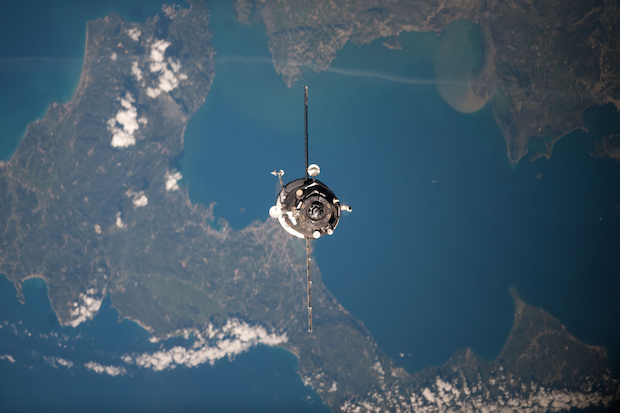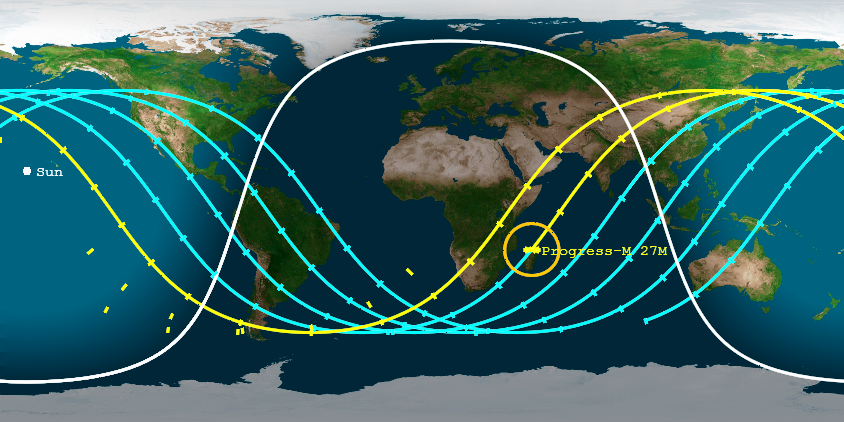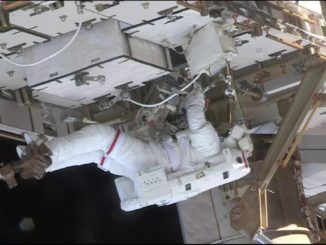Updated at 10:15 a.m. EDT (1415 GMT) on May 7.

A Russian space freighter that failed to deliver supplies to the International Space Station last week is due to re-enter Earth’s atmosphere as soon as Thursday.
The Progress M-27M cargo capsule spun out of control as it entered orbit April 28 following liftoff from Kazakhstan on a Soyuz rocket. Video transmitted from a camera affixed to the supply ship showed it rotating rapidly, and Russian ground controllers gave up plans to dock the unmanned vessel to the space station.
Investigators are looking into the cause of the mishap, with attention focusing on the Progress spacecraft’s deployment from the third stage of its Soyuz rocket booster.
The first results of the inquiry are due May 13.
The Soyuz rocket deployed the Progress resupply freighter into an orbit below the space station, and the spacecraft will succumb to atmospheric drag without a way to boost its altitude.
The launcher’s depleted third stage fell back to Earth on April 29, and the Russian space agency — Roscosmos — said Thursday it forecasts the Progress spacecraft will re-enter in a nearly four-hour window opening at 2213 GMT (6:13 p.m. EDT) Thursday and closing at 0151 GMT (9:51 p.m. EDT).
The website Space-Track.org, which uses U.S. military tracking data, gave a re-entry prediction of 0136 GMT Friday (9:36 p.m. EDT Thursday), plus or minus two hours.
Another projection issued by the Aerospace Corp. early Thursday — before the Roscosmos and Space-Track.org predictions — indicated the Progress spacecraft would likely re-enter in a 10-hour period centered on 0540 GMT (1:40 a.m. EDT).
The forecasts are closer in agreement than the predictions issued earlier in the week, illustrating the difficulties in projecting when unpiloted satellites and space junk will plunge back to Earth. Analysts usually refine the margin of error closer to the expected re-entry time, but it is impossible to pinpoint where an object will come down.
European Space Agency space debris experts said Thursday the current re-entry window indicates a low likelihood the Progress will come down over North America or Europe.
“The current large uncertainty is due to the unpredictability of the drag forces working on the vessel, and is a standard feature of such predictions,” ESA officials wrote in a blog post on the agency’s website. “Any reports claiming precise re-entry times and locations at this stage are speculative.”
ESA said tracking data showed the Progress was spinning once every 1.8 seconds. As of Wednesday, the spacecraft was circling Earth at an average altitude of about 108 miles.
The sun helps determine when an object will re-enter. Elevated levels of solar activity inflate the Earth’s outer atmosphere, giving more aerodynamic resistance to low-orbiting satellites and hastening their return to the ground.
Roscosmos officials said the bulk of the Progress M-27M cargo ship, which is not fitted with a heat shield, will burn up during the scorching re-entry. Only a few fragments of the spacecraft sould reach Earth’s surface, according to the space agency.
Bill Ailor, an expert on spacecraft re-entries at the Aerospace Corp., said about 10 to 40 percent of the mass of objects falling back to Earth through the atmosphere typically reach the surface.
The 7-ton Progress spacecraft, potentially still carrying a sizable amount of toxic fuel, orbits Earth at an angle of 51.6 degrees to the equator. Any debris that does fall will impact somewhere in a swath between 51.6 degrees north and south latitudes.

The capsule launched with more than 6,000 pounds of supplies, food and experiments for the space station and its six-person crew. The Progress carried dry goods inside a pressurized cargo module, plus tanks with water, air and propellant to refuel the space station.
Despite the capsule’s lack of a heat shield, supplies packed inside the Progress have a better chance of weathering the re-entry because high-temperature plasma must burn through the craft’s structure before reaching its interior, according to Ailor.
“Given the fact that material inside is somewhat protected during the early parts of re-entry, maybe somewhere 2,500 to 3,500 pounds of material might survive,” Ailor wrote in an email to Spaceflight Now. “Much of this material would itself be broken into smaller pieces and spread along a footprint several hundred miles long.”
The risk of the uncontrolled re-entry to the public is small, and no one has ever been injured from a manmade object falling from space. Most of Earth’s surface between 51.6 degrees north and south latitudes is ocean, and vast regions of most continents are unpopulated.
Recent publicized re-entries include NASA’s Upper Atmospheric Research Satellite, which was around the same mass of the doomed Progress freighter. Ailor said no pieces of the spacecraft were ever found after it fell to Earth in September 2011.
Hundreds of small objects come back to Earth every year, according to the Aerospace Corp.
The failed cargo mission should have no impact on the space station crew.
NASA says the space station astronauts are well-provisioned, and an accounting of the orbiting lab’s consumables shows the residents have enough food to last until early September, even without more cargo deliveries planned over the next few months.
At the end of Progress resupply missions, space station crews load the Russian cargo capsules with trash for disposal. After undocking, Russian ground controllers guide the vehicles to re-entry over the uninhabited South Pacific Ocean, away from land masses and heavily-trafficked sea and air corridors.
Email the author.
Follow Stephen Clark on Twitter: @StephenClark1.



